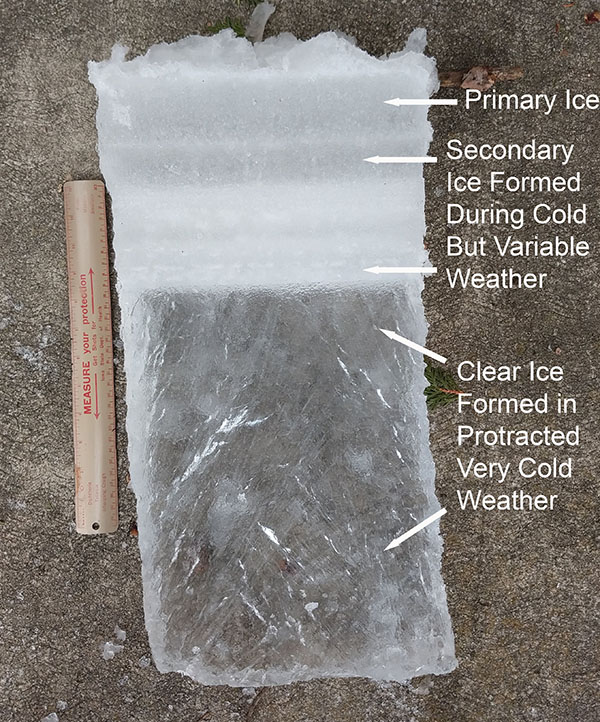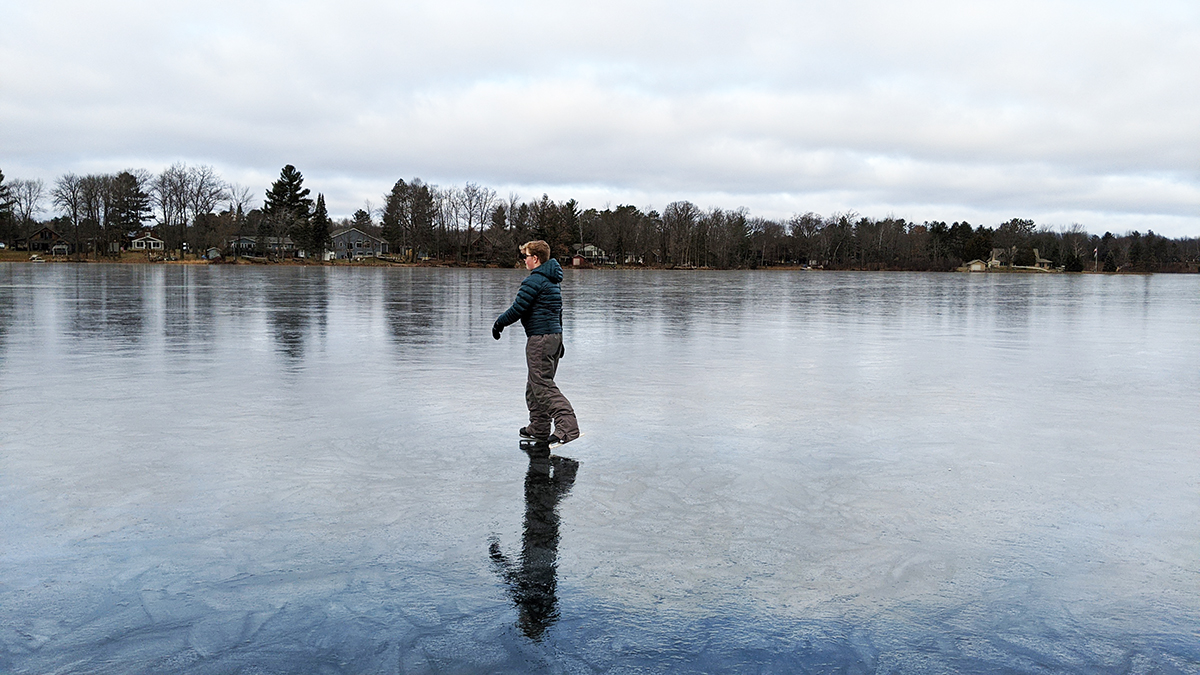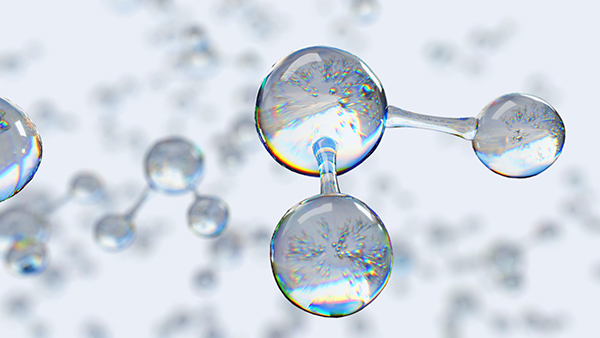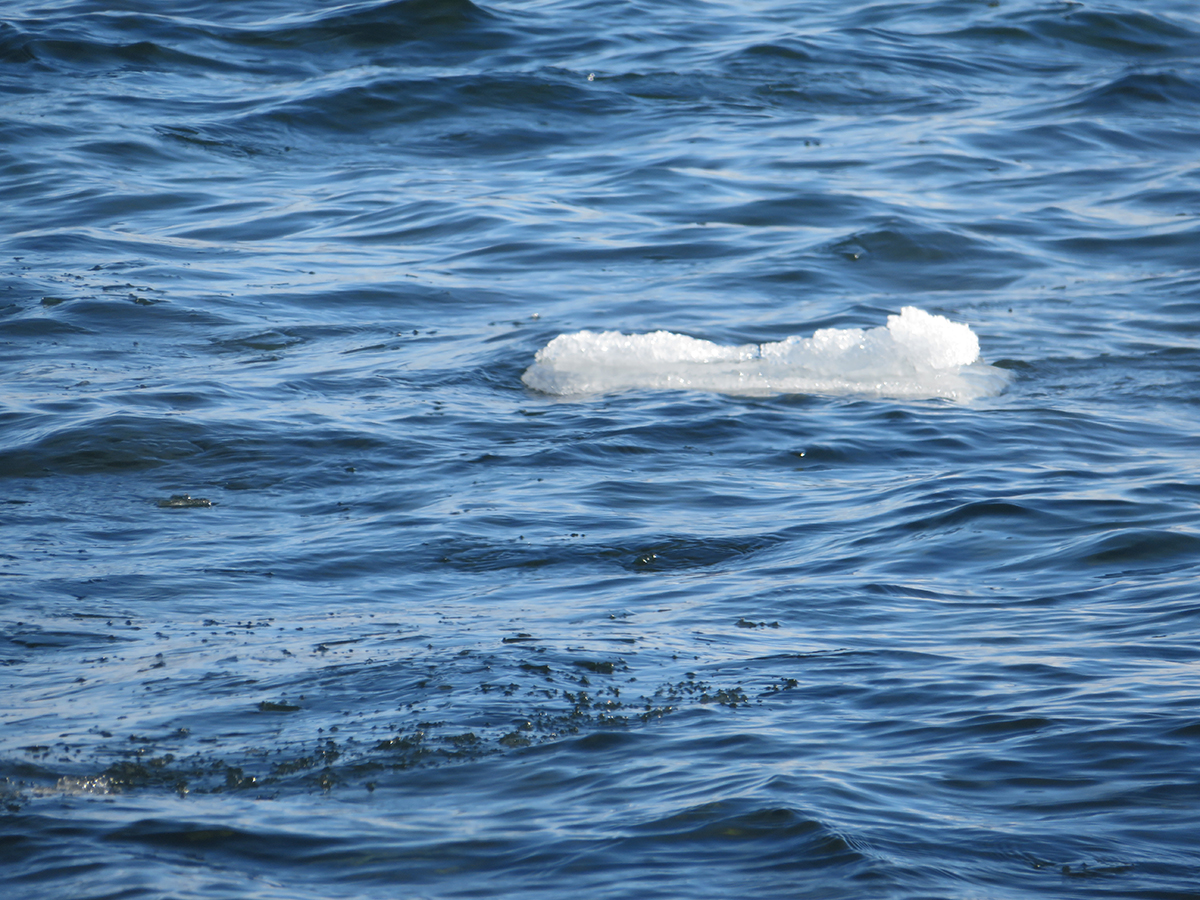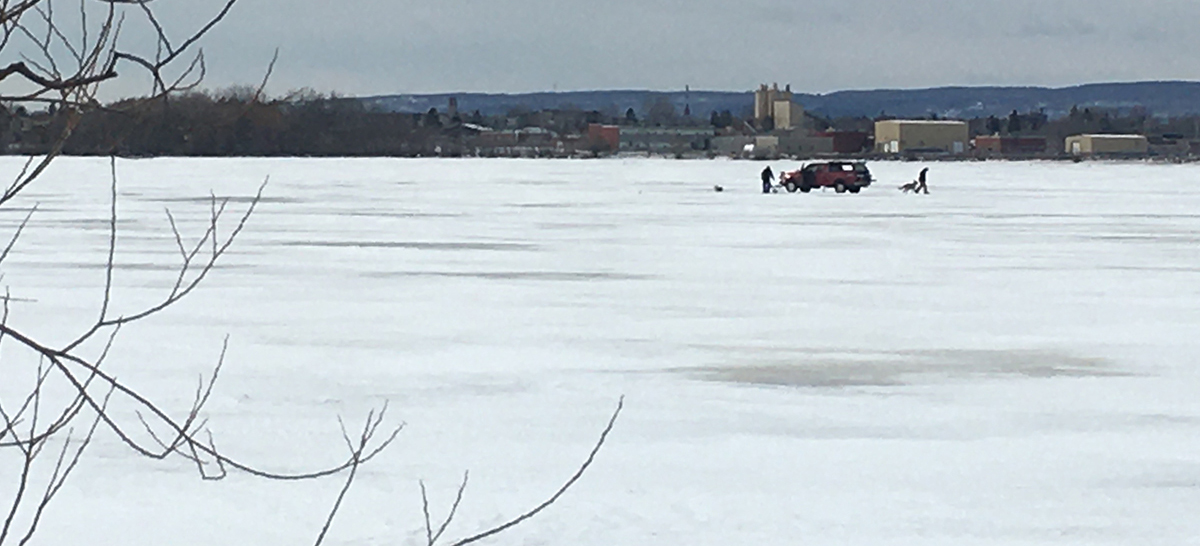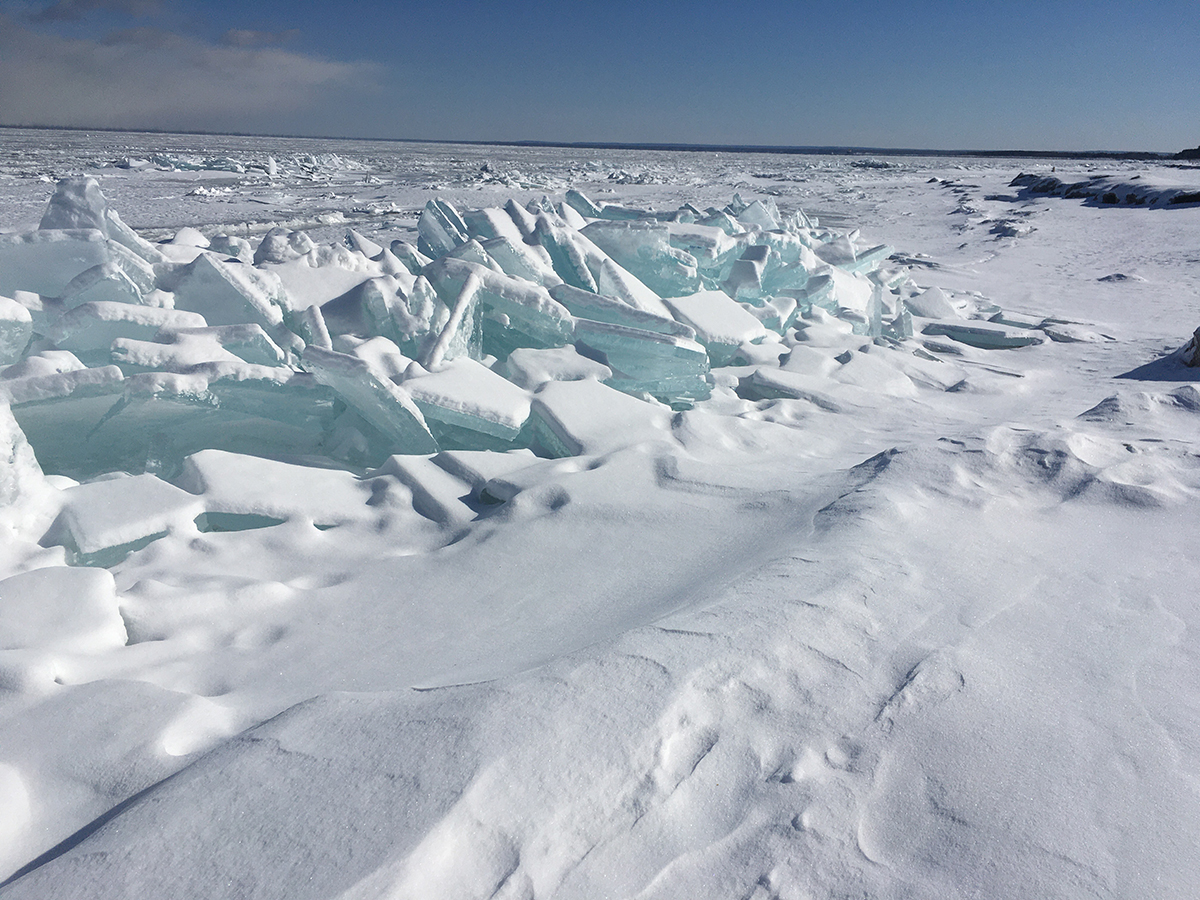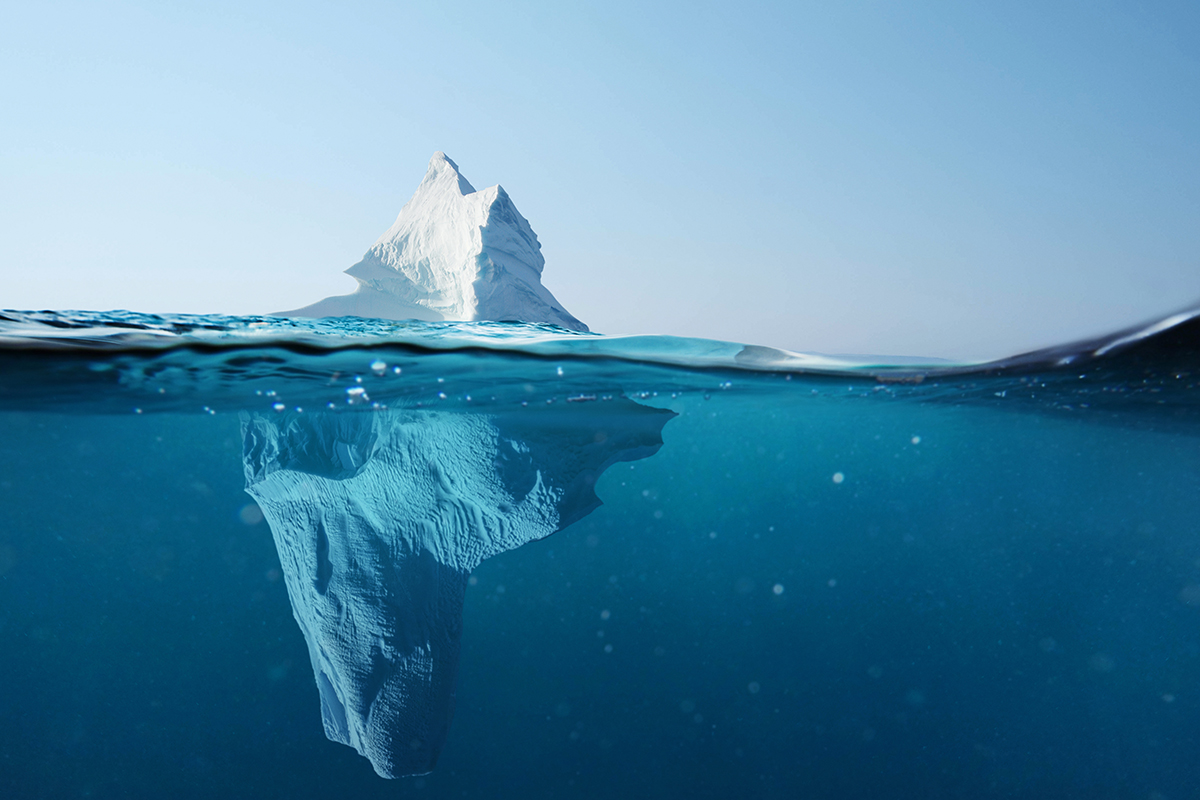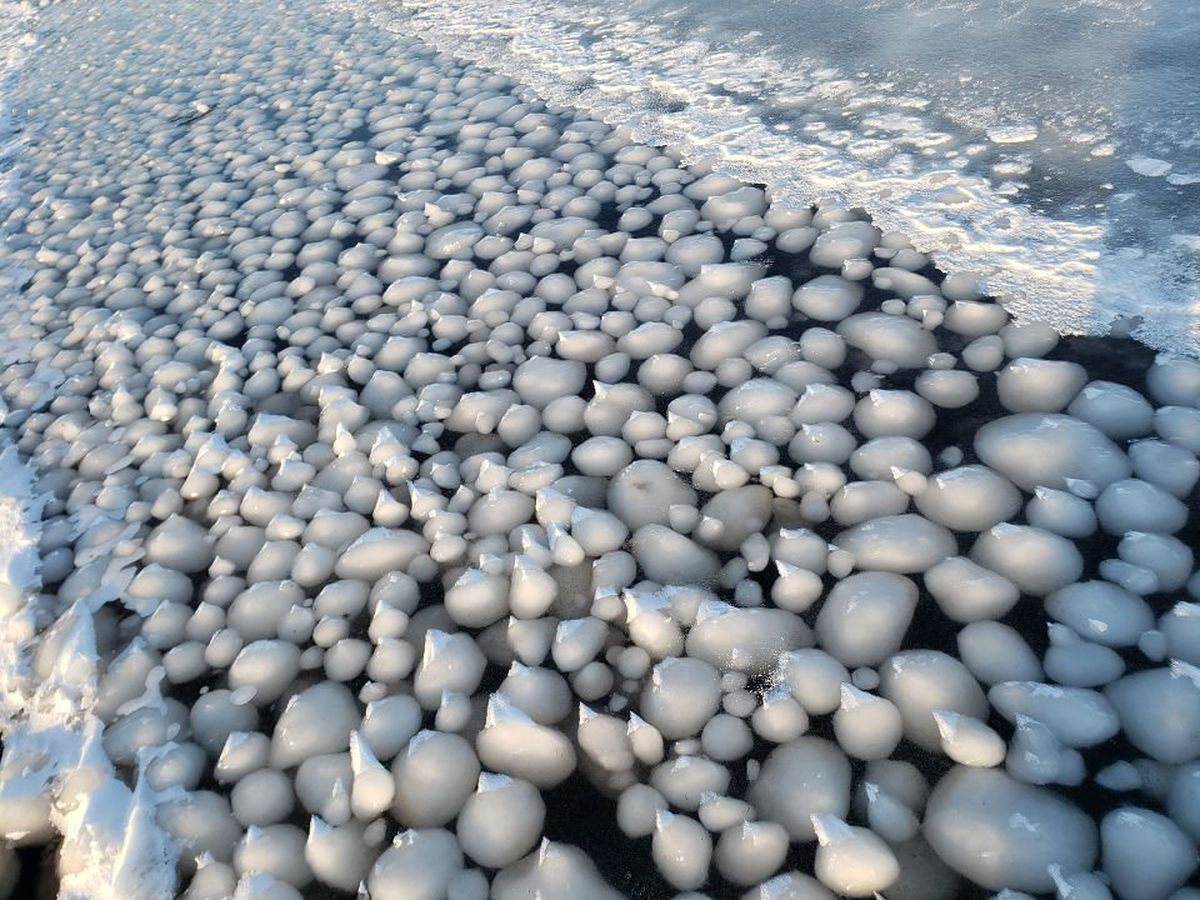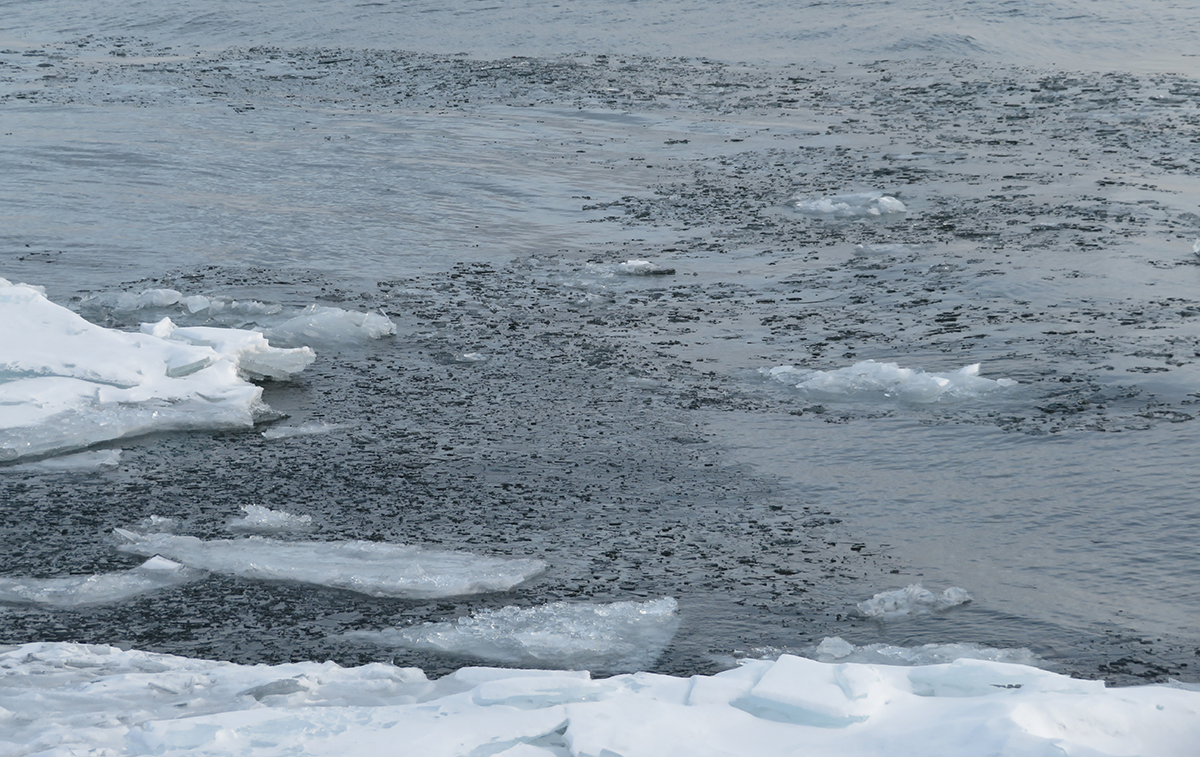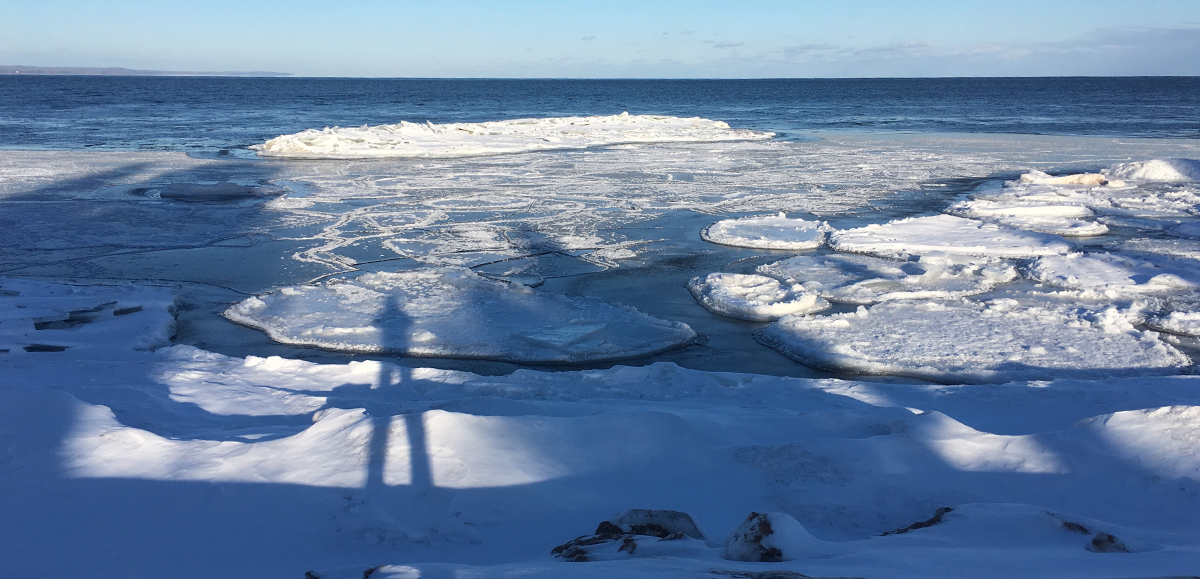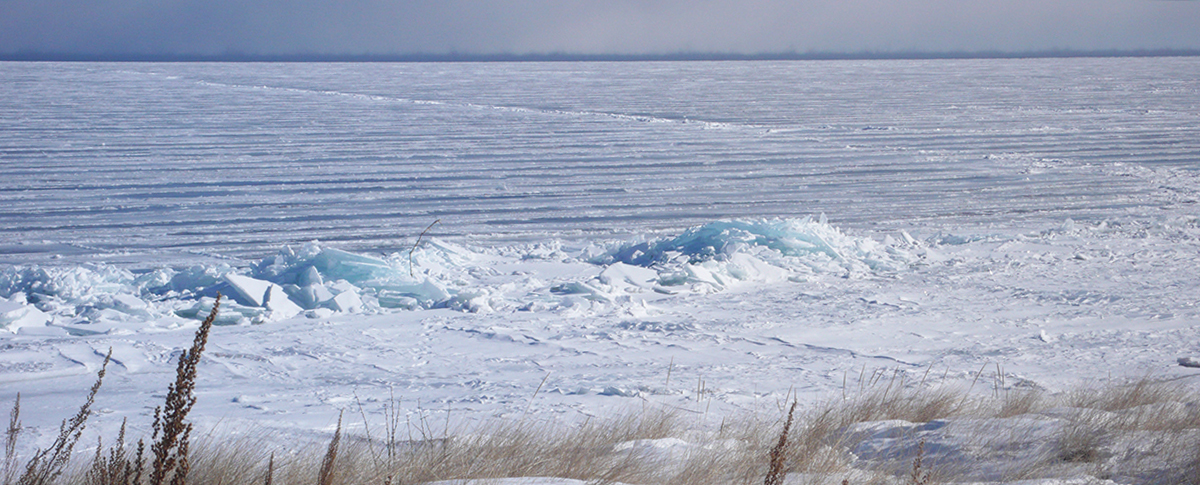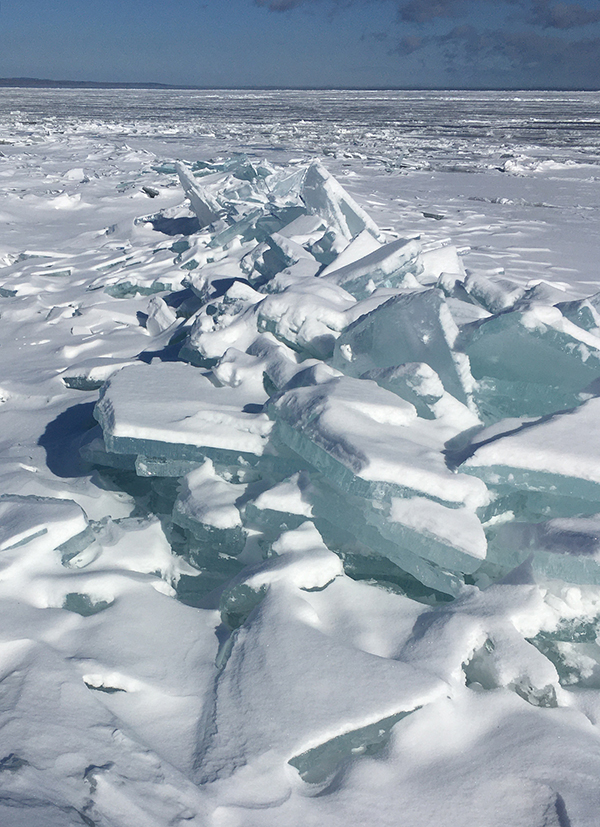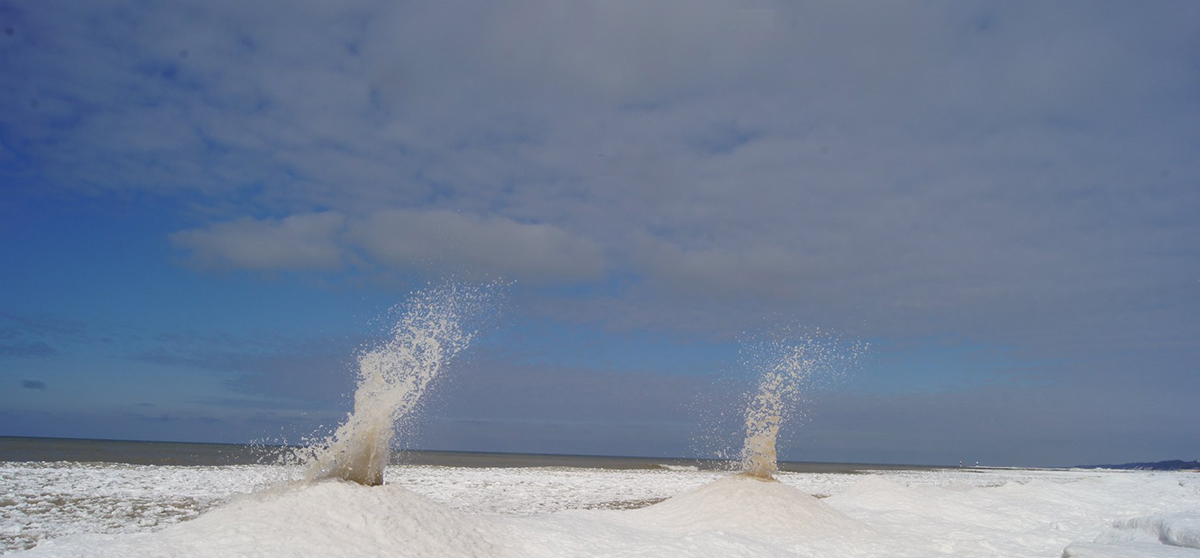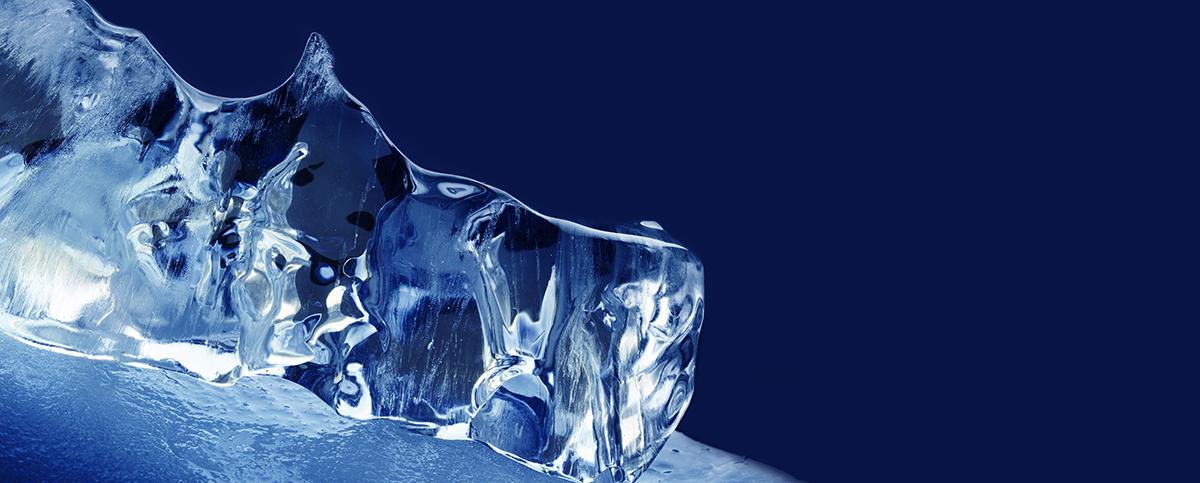
Image credit: ©besjunior. stock.adobe.com
Ice Formation is Not a Singular Phenomenon
Lake and river ice is an amazing, dangerous, and wonderful thing. My home office overlooks the Duluth harbor with a view out to Lake Superior on one side and the St. Louis River on the other. This winter when I take breaks from working at my desk, I look out at the forming, drifting, breaking, and piling ice and see more than simply ice. The formation of ice on lakes is important due to its influence on lake biology, shore structure, navigation, and recreation. It is also a source of economic cost due to the shore and infrastructure damage it can cause.
Ice is all around us in winter in the temperate zone, but I doubt many of us consider how it is formed. We talk about ice-up of lakes as if it is a singular thing. In reality though, it happens in many different ways and may be very different in the same lake in different years. The cyclic nature or phenology of ice-up makes a huge difference in the quality of the ice and changes the under-ice environment as well as the safety of lake ice cover.
What Determines How Ice Forms?
The two most important factors in determining how ice forms are temperature and turbulence (Michel and Ramseier 1971). Temperature is under the control of climate and turbulence is affected by the size of the water body and the materials that make up the bottom and sides of that water body. Turbulence in streams is driven by the speed of water and by the kinds of materials that form the stream’s channel. Bumpy materials result in more turbulence. Turbulence can also be high in large lakes when the wind can blow over the water surface for large distances and creates waves and currents.
Calm Water Ice Formation and a Quirk of Density
Under calm conditions, ice freezes on lakes very similarly to how it freezes in an ice-cube tray. Lake ice freezes first at the surface starting at the edges or shoreline for two reasons.
Water near the shore is typically shallower and contains less heat than deeper water so it can reach the freezing point faster than deeper water. But curiously, as water cools from 40 degrees F (4 degrees C) to the freezing point it becomes denser or said another way, its weight per unit of volume increases. So, you might ask, if denser water sinks, why does the ice form on top?
Quirk alert: As water approaches its freezing point (32 degrees F / 0 degrees C) it becomes less dense than the water around it and rises to the top of the surrounding water.
Primary Ice and Fast Ice
Image credit: John A. Downing/Minnesota Sea Grant.
In a calm lake or pond, the first ice or “primary ice” is quite clear and crystalline and is made up of hexagonal plates, needles, or sheath-like structures with large crystals oriented up-and-down.
Image credit: John A. Downing/Minnesota Sea Grant.
Image credit: Titus Seilheimer/Wisconsin Sea Grant
When the ice cover expands from the shore to the entire lake surface, it’s called "fast ice" because it is held fast by the shore. When conditions are cold and calm, this is the ice-up condition that can create excellent skating at the beginning of the season as long as snow does not accumulate and warm weather does not cause surface melting.
Ice Molecules and Clarity
Image credit: ©artegorov3@gmail. stock.adobe.com
Water molecules are composed of two hydrogen atoms that are each attached to the same oxygen molecule in a triangular formation. In liquid water, these molecules arrange themselves randomly. In ice, the molecules align themselves in a regular lattice pattern and are more spread out, which results in ice being less dense than water. Because the crystal lattice allows a lot of light to pass through, the under-ice environment is surprisingly bright. Aquatic algae and plants can grow under lake ice.
Rough Water Ice Formation and Frazil
Image credit: John A. Downing/Minnesota Sea Grant.
Under turbulent conditions, ice freezes in a less orderly and transparent way than in calm water conditions. In turbulent conditions, initial ice formation is due to the formation of what is called frazil ice or fine ice crystals suspended in the water. Frazil ice is usually smaller than one inch in length, and is shaped like sharp-pointed objects or small disks (Pounder 1965).
Frazil forms in the top inch or so of the moving surface water because the water there is colder than the water below - the same reason as clear ice forms toward the surface.
Frazil clumps together quite easily and forms a sort of slush at the water’s surface and can pile up and accumulate when pushed by wind or currents. When the slush clumps together it forms “sludge ice” (Armstrong and Roberts 1956). Sludge ice decreases surface turbulence because it is viscous and when it freezes it can create a solid ice cover at the water’s surface. Although clumps or rafts of frazil and sludge can accumulate in open water creating ice floes, the action of wind and current normally make this ice grow from the shore outward.
Because the frazil crystals are small and oriented in a variety of directions and the freezing of frazil incorporates gas bubbles and other materials, the primary ice that forms under turbulent conditions is usually less transparent and less smooth than ice formed under calm conditions. Again, this process continues until the surface of the water is covered with fast ice that is attached to the shore.
Floating your Truck on a Lake
Image credit: M. Thoms/Minnesota Sea Grant
The way ice forms is important for safety and ecology. The “white ice” formed from snow, sludge or under turbulent conditions is much weaker and breaks more easily than the “black ice” formed under calm conditions or at the interface between ice and water.
Weight, like my pickup truck, when applied to ice is supported by the water underneath it and not by the ice (Ashton 2010). This way of thinking about ice stopped me cold for a moment.
You may remember Archimedes’ principle from high-school physics. According to the legend, when Archimedes was sitting in a bathtub, he noticed that the water level rose by an amount equal to the mass of his body. From that observation he concluded for an object to be buoyant in water it must displace enough water to be equal to the mass of the object.
In order for ice to float my pickup truck that ice must deform or bend downward to displace an amount of water equal in mass to my pickup truck. If the ice is not stretchy or strong enough to deform and spread the mass of my truck out over a large enough area, the ice will crack and fail. Water will flood the crack and my truck will sink just like a boat with a hole in it. Ice that has formed under turbulent conditions, which is often white ice, is weaker than ”black ice” because it is made of tiny size of crystals (Cherepanov 1974) that will break easily. Additionally, white ice lets less sunlight through it than ”black ice” which means the environment beneath white ice will be darker and less primary production will occur to renew the oxygen under it.
Ice is a Process
Anyone who has watched ice form in the early winter knows that the process can go on for quite some time and is often discontinuous. As weather gets warmer and cooler, ice breaks apart and is pushed back together. Drifting ice is called “pack ice” and is composed of sheets of floating ice called floes that are separated by water. When floes are pushed together so when one floe moves on top of another this is called “rafting.” When sheets of regular, flat, lake-ice (level ice) are broken and haphazardly pile up, this is called “hummocked ice.”
Image credit: M. Thoms/Minnesota Sea Grant
Hummocked ice happens frequently along shores with wind exposure and can cause shore soils and material to be pushed inland. This ice-push, which is also called ice ride-up, ice surge, or ice ramping, can be quite violent and can cause severe damage to shore infrastructure, especially when ice breaks up under high wind stress.
What’s Happening Down Below?
Secondary ice is formed at the bottom of the surface ice by the clumping of frazil, the consolidation, freezing, and crystallization that results when heat moves up through the water toward the surface. This often soupy ice layer can be created from a slurry of frazil or simply by the crystallization of new ice below the primary layer. Another layer of ice is “superimposed ice” (Michel and Ramseier 1971) that forms over the top of primary ice. Most of us have sunk through superimposed ice after the ice has been through a few freeze-thaw cycles. Superimposed ice forms when water has flowed out onto the surface of the primary ice or onto the snow covering primary ice. The water can be from runoff from shore, shallow groundwater seepage from above the ice surface, rainfall, stream inflow, or surface snow and ice melted from the warm sun. Although superimposed ice freezes at the top, it sometimes leaves a considerable slush and water layer beneath it and above the primary ice.
Why Ice Floats and Bergy Bits
Image credit: ©alonesdj. stock.adobe.com
The principle explaining why ice floats is the same for what we erroneously call icebergs on Lake Superior and for the ice in your beverage. Ice floats because it is 9% less dense than liquid water of nearly the same temperature. It’s that 9% of the ice that’s floating above the water level of the lake or your drink. To be classified as a true iceberg, the height of the ice must be greater than 16 feet above the water surface, the thickness must be 98 to 174 feet, and the ice must cover an area of at least 5,382 square feet. What we see on Lake Superior are rarely the size of a true iceberg and are more likely to be what are called “bergy bits” or “growlers.”
Bergy bits are pieces of ice that are generally greater than 3 feet in height, less than 16 feet above the water level, and 1,076 to 3,220 square feet in area. A bergy bit protruding just 3 feet above the water would have about nine times as much ice under the water as above it. A growler is a piece of ice roughly the size of a truck or grand piano that is low enough to the water that waves can wash over it.
When is Ice Safe for People, Trucks or Horses?
After ice-up there is usually a time period when ice cover looks good but is highly unsafe. People may also mistakenly assume ice thickness to be fairly uniform across a lake, but this is far from true (Brown and Duguay 2011). Bengtsson (1986) measured ice thickness in many places across several lakes and found that ice thickness could vary by more than 50%, especially when stream inflows or outflows are within a mile or so. Variations in ice thickness result from the way in which ice is formed and what happens to it over the winter.
The rate at which ice thickens depends on the temperature at the bottom of the ice where it meets the underlying water and the thickness of the ice. When ice is thin, heat from the water below that ice can escape to the air relatively quickly, which cools the water and allows ice to form. When ice is thick, the heat of the water escapes more slowly into the air, which means the water stays warmer longer and it takes longer for thick ice to become thicker.
In-shore ice forms first so may be thickest once a lake is completely covered in ice. Bays and harbors that freeze rapidly in the early winter may also initially be thickest. As winter proceeds, ice thickness can tend to even out across a lake (Bengtsson 1986). For example, when snow drifts onto thinner ice, it can slow the thickening of that ice through insulation. While the thicker ice continues to slowly grow thicker, the now-insulated thinner ice is also growing thicker more slowly.
Later in winter, in- and near-shore ice may be thinnest because of the inflow of groundwater and the activities of winter-active mammals. Black or crystalline ice tends to grow on the bottom of the ice cover whereas white ice grows on top of the ice due to the freezing of snow (Bengtsson 1986).
Caution is always advisable when working or recreating on ice. When my grandmother was a child, their family lost two teams of horses through the ice on the lake where I grew up. I know exactly where they went in because, due to groundwater or other currents, that area which is about 100 feet from shore still always has thin ice.
Anchor ice
Anchor ice is usually formed under currents or stream flow when super-cooled pieces of frazil stick together and stick to the bottom forming a bottom layer of ice. This is formed frequently in streams and rivers when water is supercooled but also can form in lakes (Kempema et al. 2001). In all cases, release of anchor ice transports a lot of sediment and can cause impairment of power generation and habitat.
Beach ice balls
Image credit: National Weather Service
Balls of ice that are formed on beaches and sometimes jokingly referred to as mermaids’ bowling balls (Eisen et al. 2003). These can be up to the diameter of a soccer ball and can be made of ice or ice covered in sand and sediment. They are likely formed as slush balls by wave action and rolled up the beach by waves or by tides in marine systems.
Black ice
Thick pieces of clear, primary ice that have grown uniformly and appear black because light passes through them instead of being reflected back to the eye. Broken edges of black ice sometimes glow in the sun because they conduct light from behind them.
Brash ice
Floating pieces of broken ice, usually less than about 6 feet across.
Candle ice
Candle ice is rotten ice that leaves long, thin crystals as it melts. This is usually found when primary ice melts that was formed under very cold conditions (Muguruma and Kikuchi 1963). Candle crystals can be oriented either vertically or horizontally (Knight 1962) depending on wind patterns. If the candle crystals are vertical the ice surface appears white, if the candle crystals are horizontal the ice appears darker. Vertical candle crystals are stronger than horizontal ones.
Frazil and frazil slush.
Image credit: John A. Downing/Minnesota Sea Grant.
Frazil are the small needle-like or plate-like ice particles that form at the water surface when the temperature above the water is below freezing. These particles are generally smaller than about one inch. They tend to stick to each other in very cold water and form frazil slush. The slush can freeze quite rapidly into primary ice. Frazil gives a dull appearance to the water because it scatters light.
Frost smoke
Image credit: M. Thoms/Minnesota Sea Grant
Sometimes called “lake smoke,” it is caused by contact of cold air with the relatively warm water either in gaps in ice or beyond the ice edge. If the temperature is very cold, this moisture may be composed of small ice crystals. Frost smoke can create substantial clouds and is sometimes associated with lake effect snow in the Great Lakes.
Ice rind
A crust of ice on the surface that comes from the freezing of sludge on a calm water surface. It is usually less than a few inches thick.
New ice
The first layer of ice formed and similar to primary ice.
Pancake ice or ice pans
Image credit: M. Thoms/Minnesota Sea Grant.
Rounded pieces of ice frozen from snow or frazil slush balls that have raised rims from repeatedly colliding with other pieces of ice. These are usually less than 2 feet in diameter.
Plate ice
Thin and often very clear pieces of ice often formed under calm conditions (Michel 1971). These are often small and dinner plate size. They look like thick, broken, plate glass.
Primary ice
The first layer of ice that forms on a water body. Depending on turbulence, it may be a clear skim of ice that thickens with time or it may be a congealed layer of frazil or snow-slush. The ice grain size varies from very large when formation is under calm conditions to very small when surfaces are agitated. When the surface is calm and the temperature gradient is large, diverse shapes of crystals can be formed, ranging from flat to needle-shaped with crystals often as large as a few to several inches.
Rotten ice
Melting ice that has or is losing its integrity. It can have a honeycomb appearance.
Secondary ice
The subsequent formation of ice below the primary ice. This ice can have diverse forms that are determined by the texture of the primary ice. If the primary ice is clear and uniform, secondary ice may be crystalline, formed of columns of crystals. If the primary ice was formed under turbulence, the secondary ice may be made up of frazil or snow-slush deposited beneath it. In most cases the secondary ice becomes integrated with the primary ice into a solid ice cover.
Snow slush
An accumulation of surface slush due to the agglomeration of ice crystals formed around a central area of crystals (i.e., nucleated) in very cold water by particles of snow.
Sludge
A viscous, soup-like layer of frazil forming at the water surface. Like frazil, sludge gives a dull appearance to the water because it scatters light.
Slush balls
Slush sometimes takes on a spherical form when clumps of viscous slush or frazil is processed by currents turning them or wave action rolling them. The slush in these balls sticks together much like wet snow rolled into a ball to make a snowman. This action can be back-and-forth, driven by waves, or round-and-round, driven by currents.
Snow ice
Formed over the top of the primary ice by the freezing of snow wetted by external water inflow or melting from warm weather or intense sun. If it is thick enough, the freezing of the top of the snow slush may leave a layer of snow slush between it and the primary ice.
Superimposed ice
Ice forming over the top of the primary ice layer through flooding of the ice surface by water from sources such as stream inflow, meltwater, groundwater discharge above the water surface, or other sources. Superimposed ice will freeze at the surface, sometimes leaving a slush layer beneath it.
Bay ice
Fast ice held shore to shore within a bay or recess in a coastline formed by a bay (i.e., embayment).
Bergy bit
A small iceberg-like fragment of ice floating with free ice up to 15 feet above the water. Generally, in lakes and rivers, these are composed of broken-off pieces of hummocked ice.
Bight
A broad indentation in the ice edge formed by wind, waves, or current. Bights form a broad crescent shape in the ice edge that has the form of a wind-swept shore.
Crack
Image credit: M. Thoms/Minnesota Sea Grant.
A fracture or rift in ice. These can be very tight with no water showing between the ice on either side up to the width that one could jump across.
Fast ice
Ice fastened to the shore and therefore held fast. It generally is found where it is formed and not created from drifting ice. See the image accompanying the "crack" entry for an example of fast ice.
Floe
Ice that is not fastened to the shore. Small floes are larger than ice cakes and are 30 to 600 feet across, medium floes are 600 feet to one half-mile across and large floes are one-half mile to 6 miles across. Larger floes are called “vast” floes. “Light” floes are 3 feet or less in thickness. Thicker floes, normally made of hummocked ice, are called heavy floes.
Frost heave or ice heave
Usually occurs when ice penetrates to the bottom of a water body allowing frost to surpass the water body. Frost heave then lifts the sediments and can disturb it and allow its transport (Burn 1990).
Growler
Image credit: M. Thoms/Minnesota Sea Grant.
An almost totally submerged piece of ice that is smaller than a bergy bit.
Hummocked ice
Image credit: M. Thoms/Minnesota Sea Grant.
Hummocked ice is ice floes or broken level ice of any kind that has been pushed and piled up randomly into humps and ridges. This is often found on shore but also where floes collide. When hummocked ice has been processed by wind or waves it is called “weathered hummocked ice.”
Ice cakes
Ice floes that are less than 30 feet across.
Ice edge
The boundary between open water and large pieces of ice.
Ice jam
The accumulation of ice floes and slush in a way that impedes river or stream flow. These have been known to cause major damage to infrastructure and are the subject of a substantial amount of engineering (Ashton 2010). The force exerted by ice jams is legendary and has led to massive flooding events onshore.
Ice jacking
The cracking of ice sheets forming leads that refreeze and ratchet expansion of ice sheets beyond shores. Ice jacking can cause creeping damage to shores over a protracted period (Kavanaugh et al. 2019).
Ice-out or ice break-up
The event denoting the loss of ice cover in river and lakes. Break-up can take place over several days or seemingly instantaneously. In lakes break-up is driven by wind and warmth whereas in rivers it is driven by meltwater flow. Normally smaller water bodies that have been fully ice covered lose ice earlier in the season than large ones.
Ice-push, ice ride-up, ice surge, ice ramping, or ice piling (sometimes incorrectly called ice-heave).
Because in all but the largest lakes, ice melts fastest near shore, lakes form a shore lead or open space between the ice sheet and the shore. When wind blows across the ice sheet it will develop a terminal velocity of about 3% of the wind speed. Thus, ice sheets can develop tremendous momentum (momentum equals mass times the square of velocity) (Ashton 2010). It only takes about 4 cubic yards (about 8 square yards) of melting ice to have the same mass as an average skid steer. Considering a 30-mph breeze, the ice could have a velocity of about 1 mph or about the same velocity of a skid steer while working. Therefore, ice-push can do a lot of damage to shore infrastructure but also creates natural ice ramparts along shores (Wagner 1970). The distance ice will push inland increases with the wind velocity, the size of the floe, and the density of the ice, and decreases with the angle of the shore slope and the floe thickness (Ashton 2010). The height the ice will move up onto the shore or the height of a pile of ice increases with the wind speed and the size of the ice sheet and decreases with the height of the shore and ice pile above the water and the angle the shore and ice-pile rises above the horizontal (Tsang 1974). This implies that ice-piling is somewhat self-limiting.
Ice ramparts
Shoreline berms of terrestrial materials caused by ice-push. These occur most often in lakes greater than one-half mile in diameter with even shorelines, moderately sloping bottoms (about a 10-30% slope), and shore sediments that are sand or gravel (Wagner 1970).
Ice sheet
A large expanse of snow and ice horizontal to the water surface.
Icequake
A seismic event caused by a sudden cracking and failure of lake ice due to sudden expansion of an ice sheet due to quick atmospheric warming exacerbated by low snow conditions and high water levels. Some of the largest of these have registered 2.0 on the Richter scale (Kavanaugh et al. 2019), equivalent in local force to many earthquakes. Icequakes can cause extraordinary damage to shores.
Ice-up
The freezing over of a water body. This process takes much longer in larger bodies of water than in small ones.
Ice volcano
Image credit: National Weather Service Grand Rapids, Michigan.
A cone-shaped ice mass formed over a lake via the eruption of water and slush through an opening in an ice shelf. Lakeward V-shaped channels in the shore ice accelerate water that spews up out of the conical ice formation. The freezing spewed water adds ice and other materials to the sloping sides of the “volcano.” These formations can be up to 15 feet tall and usually occur after winter storms. They can be spaced along shore in a similar way to beach cusps (Fahnestock et al. 1973).
Lead
A crack in ice that is large enough for a boat to pass through.
Level ice
Flat ice that has not been hummocked.
Pack ice
Ice, other than fast ice, that is made up of pieces of ice. Components of pack ice are often interspersed with water. “Very open” pack ice has as little as one-eighth of the area composed of ice whereas “very close” pack ice is more than seven-eighths ice. “Open pack ice” is made of floes separated by leads and pools and can sometimes be navigated through. “Close” pack ice has most floes in contact and is very difficult to navigate. “Consolidated” pack ice has all floes frozen together.
Patch
A cluster of pack ice that can be seen across from your vessel.
Polynya
A large area of open water in the ice that occurs annually. These can have one side open to the shore and often occur near rivers.
Pool
An open water area enclosed in pack ice.
Pressure ridge
A wall or ridge of hummocked ice where floes are pressed together or floes are pressed against fast ice. In smaller lakes, these often occur near ice-out at the mouths of bays or at the interface of large basins.
Shore Ice
Another name for a narrow strip of fast ice attached to the shore.
Shore lead
A strip of open water between the shore and ice floes or ice sheets. A shore lead can also form between a narrow strip of fast ice and an ice sheet.
Weathered ice
Hummocked ice or ice in pressure ridges that has been rounded through weathering.
Winter ice
An unbroken sheet of ice at water level that is not more than one winter’s growth. Normally 6 inches to 6 feet in thickness.
Young ice
Newly formed primary ice or level ice that is usually 2 to 6 inches thick.
Bibliography
Armstrong, T., and B. Roberts. 1956. Illustrated ice glossary. Polar Record 8:4-32.
Ashton, G., editor. 2010. River Lake Ice Engineering. Water Resources Publications LLC, Highlands Ranch, Colorado, USA.
Bengtsson, L. 1986. Spatial Variability of Lake Ice Covers. Geografiska Annaler: Series A, Physical Geography 68:113-121.
Brown, L. C., and C. R. Duguay. 2011. A comparison of simulated and measured lake ice thickness using a Shallow Water Ice Profiler. Hydrological Processes 25:2932-2941.
Burn, C. R. 1990. Frost heave in lake-bottom sediments, Mackenzie Delta, Northwest Territories. Nordicana 54:103-109.
Cherepanov, N. 1974. Classification of ice of natural water bodies. Pages 97-101 in Ocean '74 : IEEE International Conference on Engineering in the Ocean Environment Institute of Electrical and Electronic Engineers, New York, NY, USA.
Eisen, O., J. Freitag, C. Haas, W. Rack, G. Rotschky, and J. Schmitt. 2003. Bowling mermaids; or, how do beach ice balls form? Journal of Glaciology 49:605-606.
Fahnestock, R. K., D. J. Crowley, M. Wilson, and H. Schneider. 1973.Ice& volcanoes of the Lake Erie shore near Dunkirk, New York, USA. Journal of Glaciology 12:93-99.
Kavanaugh, J., R. Schultz, L. D. Andriashek, M. v. d. Baan, H. Ghofrani, G. Atkinson, and D. J. Utting. 2019. A New Year’s Day icebreaker: icequakes on lakes in Alberta, Canada. Canadian Journal of Earth Sciences 56:183-200.
Kempema, E. W., E. Reimnitz, and P. W. Barnes. 2001. Anchor-Ice Formation and Ice Rafting in Southwestern Lake Michigan, U.S.A. Journal of Sedimentary Research 71:346-354.
Knight, C. A. 1962. Studies of Arctic Lake Ice. Journal of Glaciology 4:319-335.
Michel, B. 1971. Winter regime of rivers and lakes. US Army Corps of Engineers, Cold Regions Research and Engineering Laboratory, Hanover, New Hampshire USA.
Michel, B., and R. O. Ramseier. 1971. Classification of river and lake ice. Canadian Geotechnical Journal 8:36-45.
Muguruma, J., and K. Kikuchi. 1963. Lake Ice Investigation at Peters Lake, Alaska. Journal of Glaciology 4:689-708.
Pounder, E. 1965. Physics of ice. Pergammon Press, Oxford, UK.
Tsang, G. 1974. Ice Piling on Lakeshores- With Special Reference to the Occurrences on Lake Simcoe in the Spring of 1973. Scientific Series 35:12
Wagner, W.P. 1970. Ice Movement and Shoreline Modification, Lake Champlain, Vermont. Geological Society of American Bulletin 81:117-126.
Citations
Suggested Citation
Downing, John A. (2021), Lake and River Ice: Formation and Classification, Earth's Eye: An Occasional Column by Minnesota Sea Grant Director John A. Downing [Web Page], <https://seagrant.umn.edu/news-info/directors-column/lake-river-ice-formation-classification>, accessed MO/DA/YEAR.
